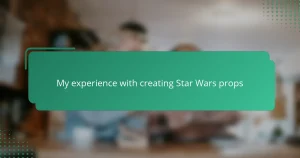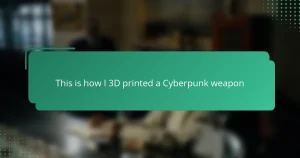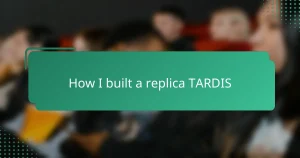Key takeaways
- Science fiction props, like Star Wars blasters, combine imagination with intricate craftsmanship, enhancing the storytelling experience.
- Building high-quality props involves selecting appropriate materials, ensuring a balance between durability and weight, and adding realistic detailing through techniques like weathering.
- Patience and a clear plan are essential in the crafting process to avoid frustration and achieve satisfying results.
- Proper display and sharing finished work with others can enhance appreciation and community connection around the artistry of prop-making.

Understanding Science Fiction Props
Science fiction props have always fascinated me because they bridge imagination and reality. Have you ever held a prop and felt a sudden connection to an entire universe? That sensation is what makes these creations more than just objects—they become pieces of storytelling.
In my experience, understanding a prop means seeing beyond its surface. It’s about appreciating the craftsmanship, the thought process, and the lore that inspired every curve and detail. When I first examined a blaster replica, I realized it carried decades of creative evolution in its design.
What truly amazes me is how science fiction props invite us to participate in fantasy worlds. They don’t just look cool; they spark curiosity and imagination. Isn’t that the core of why we’re drawn to science fiction in the first place?

Key Features of Star Wars Blasters
One thing that stands out to me about Star Wars blasters is their distinct blend of futuristic technology and rugged practicality. They look like weapons that could actually work, yet they carry that unmistakable sci-fi flair. When I first held a blaster replica, I was struck by the mix of sleek barrels and chunky triggers—details that suggest both precision and raw power.
Another feature I find fascinating is their iconic sound and visual effects. The sharp “pew pew” blasts and glowing energy bolts make them feel alive, even though they’re just props. That’s more than special effects; it’s about creating an immersive experience that pulls you right into the Star Wars galaxy. Have you ever noticed how those simple sounds instantly trigger memories of epic battles and heroic moments?
Lastly, the variety in design tells stories of different characters and cultures within the Star Wars universe. From Han Solo’s classic DL-44 to the Stormtroopers’ standard issue, each blaster reflects personality and purpose. I love how these subtle differences hint at wider narratives, making the props feel like essential pieces of a living, breathing world rather than mere collectibles.
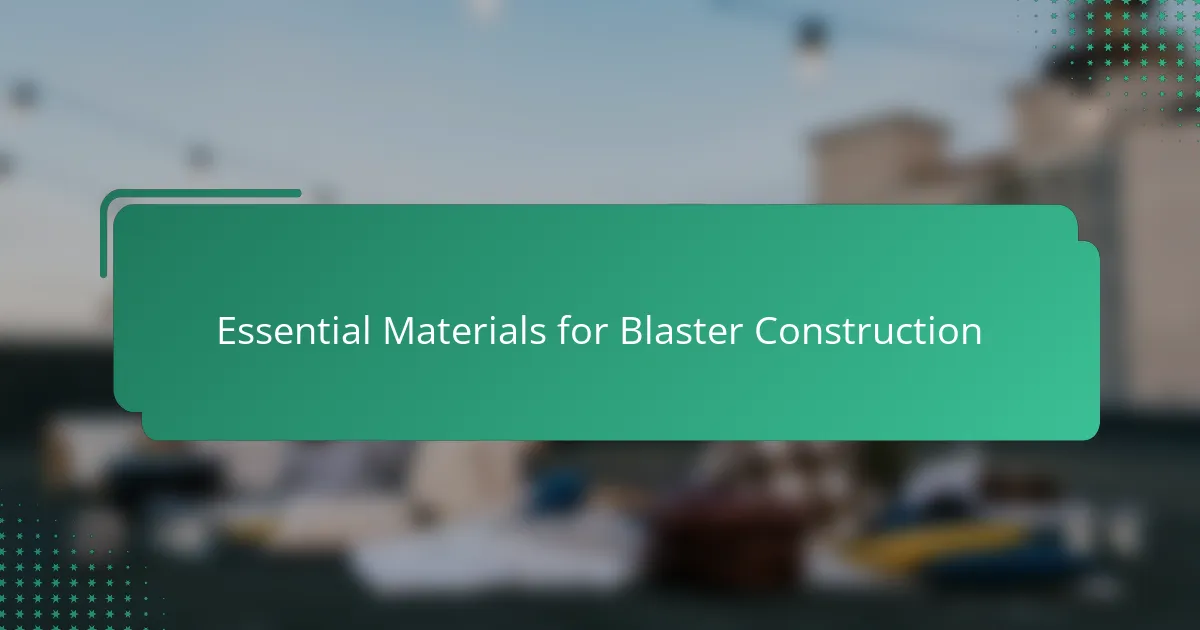
Essential Materials for Blaster Construction
When I first started gathering materials to build my blaster, I quickly realized that choosing the right base is crucial. PVC pipe or sturdy plastic tubing often works best because it’s lightweight and easy to manipulate, which makes assembly smoother and more enjoyable. Have you ever tried handling flimsy materials that just don’t hold their shape? Trust me, it’s frustrating and takes away from that authentic feel.
Another element I found essential is the use of metal components, like aluminum or brass fittings, especially for the barrel and trigger details. They add not just durability but also a satisfying weight that makes the blaster feel real in your hand. From my experience, incorporating these metals gives the prop a quality that plastic alone often can’t replicate—making it look and feel like something from the Star Wars universe.
Of course, adhesives and paints are just as vital. Industrial-strength glue keeps everything firmly attached, while layers of matte and metallic paint bring the blaster’s weathered, battle-worn look to life. I’ve spent hours perfecting these finishes, and honestly, it’s the finishing touches that transform a simple outline into a stunning centerpiece of any sci-fi collection. Have you noticed how the right paint can make all the difference?
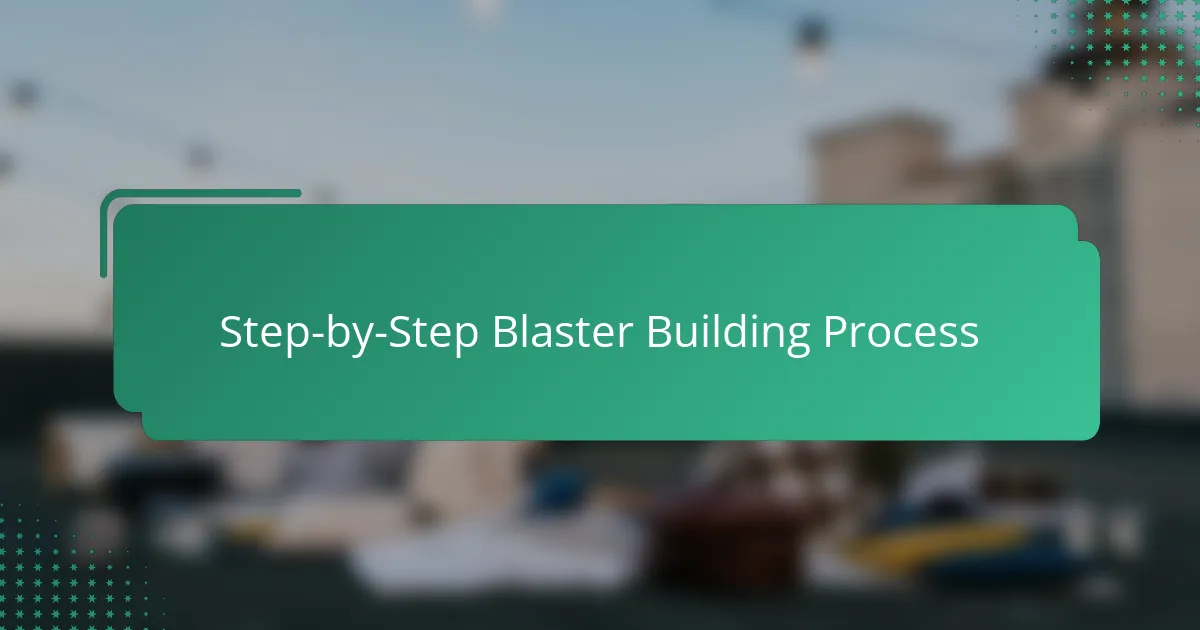
Step-by-Step Blaster Building Process
The first step I always take is to carefully sketch out a detailed plan, almost like drafting a blueprint. This process grounds the project and helps me visualize where every piece will go before I even pick up a tool. Have you ever started building without a clear map? It usually leads to unnecessary frustration down the line.
Next comes the exciting part—cutting and shaping the main body using materials like PVC pipe. I remember spending an afternoon sanding edges to get that perfectly smooth finish; it’s tedious but incredibly satisfying when you see the blaster beginning to take shape. For me, that hands-on work feels like breathing life into the prop.
Finally, assembling those smaller, intricate pieces—triggers, scopes, and barrels—is where patience truly pays off. Applying paint and weathering effects is almost like storytelling, letting me add character and history to the blaster. Do you notice how a few scratches or worn spots can transform a prop from lifeless plastic into something that seems battle-tested? That’s the magic I chase every time.

Common Challenges and Solutions
One challenge I frequently face is achieving the right balance between durability and weight. Early on, I made the mistake of using heavy metals throughout, hoping for authenticity, but quickly realized the blaster became cumbersome to hold and display. Have you ever tried holding a prop so heavy it distracts from the fun? Switching to lighter materials for larger parts while reserving metal for accents solved that problem for me.
Another hurdle is capturing the intricate details that give a Star Wars blaster its iconic look. I remember struggling with tiny components like the trigger assembly and barrel bits, which required patience and steady hands. What helped me was breaking down the build into manageable steps and using reference photos to replicate fine details accurately—this approach transformed frustration into accomplishment.
Lastly, nailing the weathered finish can be surprisingly tricky. At first, I overdid the paint layers, making the blaster look more toy-like than battle-worn. Have you found yourself going back and forth trying to get that perfect mix of scuffs and worn edges? I learned that layering thin washes and practicing subtle distressing techniques brought a more realistic and satisfying result to my builds.
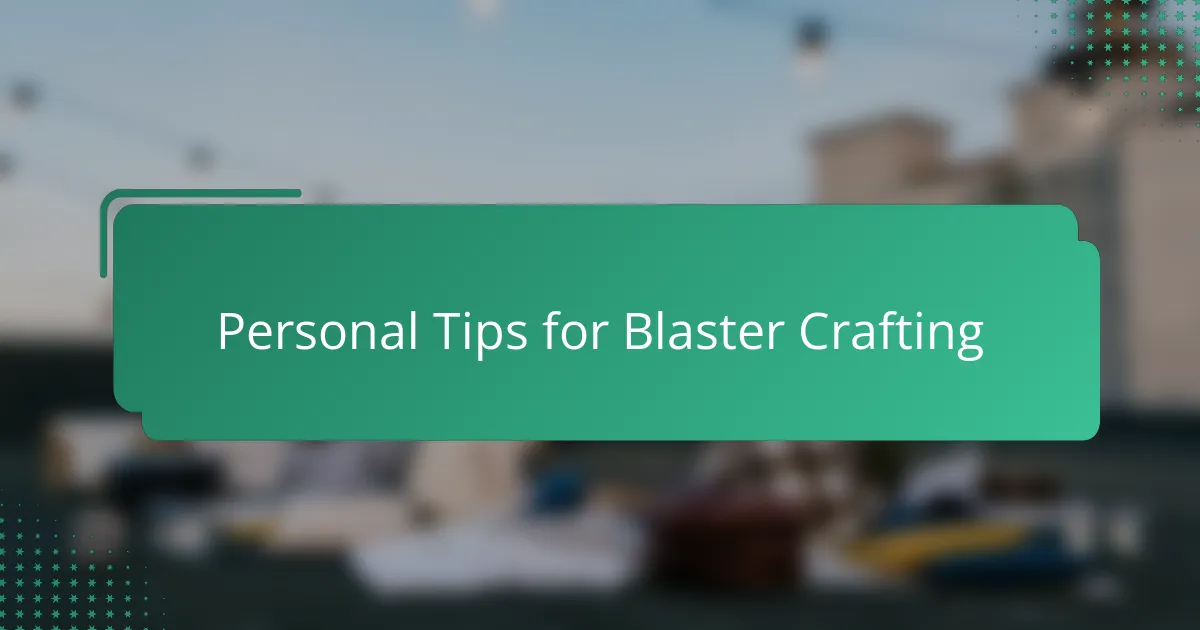
Personal Tips for Blaster Crafting
When I started crafting my first blaster, one tip that saved me countless headaches was to prioritize comfortable ergonomics. After all, a blaster isn’t just meant to look good on a shelf—it should feel natural in your hand, like it belongs in action scenes. Have you ever held a prop that felt awkward or too bulky? Adjusting grip size and balance early on can really elevate the whole experience.
Another thing I swear by is embracing imperfections. Early on, I was obsessed with making every line and edge perfectly smooth, but ironically, some slight asymmetry and roughness added character. Star Wars blasters aren’t pristine—they look used, worn in battles far from polished. Don’t shy away from subtle dents or paint chips; they tell a story that perfectly finished models sometimes lack.
Finally, I can’t emphasize enough the value of patience through each stage. Rushing the assembly or paint job often led me to sloppy results and frustration. Taking time, stepping back to assess progress, and even allowing myself breaks transformed my builds from stressful chores into rewarding projects. What’s your pace like when you build? Finding that rhythm where focus meets fun made all the difference for me.

Showcasing Your Finished Blaster
Displaying the finished blaster is one of my favorite moments—it’s like unveiling a piece of the Star Wars universe I brought to life. Have you ever noticed how lighting can completely change the way a prop looks? Setting up soft, focused lights really highlights the weathered details and metallic accents, making all those hours of painting and assembly pay off.
I usually find a spot where the blaster can be seen from multiple angles because every side tells a different part of its story. Placing it on a simple stand or even alongside other memorabilia creates a mini shrine to the craftsmanship and history behind it. Don’t you think that a well-displayed prop invites more conversation and appreciation than one tucked away in a drawer?
Sometimes, sharing photos of the finished build online or with fellow fans adds an extra layer of satisfaction. I remember feeling a real boost of pride when someone noticed a tiny detail I painstakingly replicated. It’s moments like these that remind me why the whole process is worth it—not just to own a cool prop, but to connect with a community that shares that passion.
